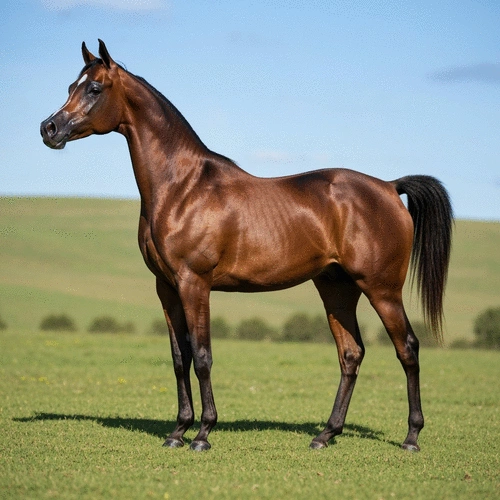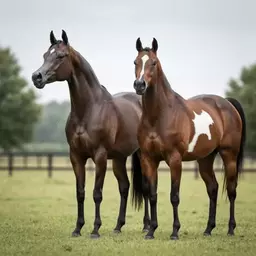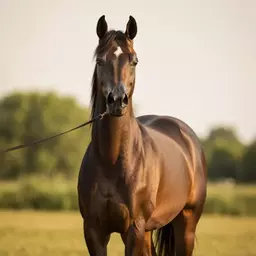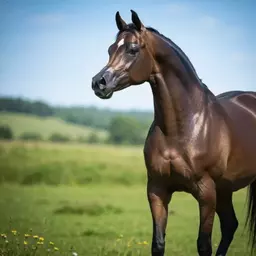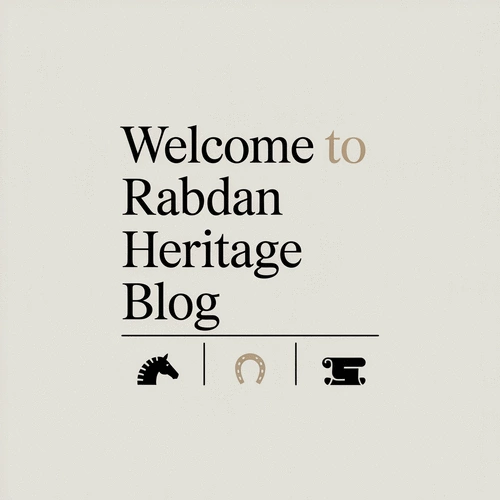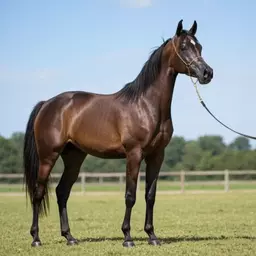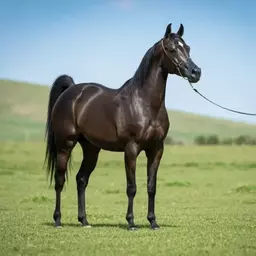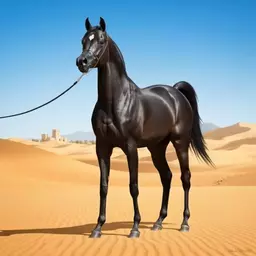The Rabdan Arabian horse's lineage is not just a matter of genetics; it embodies centuries of cultural significance and meticulous breeding. What can you learn from the fascinating history and characteristics of this esteemed breed? Let's explore the key takeaways that will enhance your appreciation and understanding of the Rabdan heritage.
What You Will Learn
- The Rabdan strain has its origins in the Arabian Peninsula, symbolizing endurance and beauty.
- Selective breeding practices have preserved the Rabdan bloodline, enhancing desirable traits while maintaining cultural significance.
- Understanding bloodlines is crucial for breeders, influencing physical traits, behavior, and the purity of the breed.
- Key features to identify purebred Rabdan Arabian horses include head shape, neck length, chest depth, and coat colors.
- Knowledge of performance traits such as endurance and temperament is vital for making informed breeding decisions.
- Each Rabdan Arabian horse carries a legacy that connects horse lovers with a rich cultural tapestry.
Key Characteristics & Lineage of Rabdan Arabian Horses
Delve into the defining attributes and historical significance that make Rabdan Arabian horses truly exceptional.
Origins & Significance
- • Arabian Peninsula roots
- • Selective breeding for nobility
- • Embodies ideal Arabian traits
Key Physical Features
- • Refined, wedge-shaped head
- • Long, elegant neck
- • Deep chest, well-proportioned
- • Chestnut, black, gray coats
Breeding & Preservation
- • Meticulous breeding programs
- • Maintains purity & integrity
- • Enhances breeding decisions
Performance Traits
- • Renowned agility & endurance
- • Calm & trainable temperament
- • High trainability potential
Understanding the Rabdan Arabian Horse: A Brief Historical Context
The heritage of the Rabdan Arabian horse is intricately woven into the history of the Arabian Peninsula, reflecting a legacy that spans centuries. As I delve into this captivating lineage, I invite you to join me in exploring the rich tapestry that forms the foundation of these noble creatures. Understanding the origins of the Rabdan strain reveals not just their physical attributes but their cultural significance as well. For further reading, explore the history and characteristics of Arabian horses on Wikipedia.
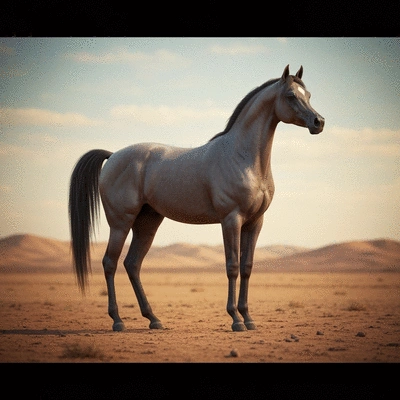
Did you know that the Rabdan bloodline is one of the most prestigious in Arabian horse breeding? This lineage has been preserved through careful breeding practices that emphasize not only the horses' exceptional qualities but also their deep-rooted connection to history. Let’s take a closer look at the origins of the Rabdan strain to appreciate what makes these horses so unique.
The Origins of the Rabdan Strain
The Rabdan strain traces its roots back to the Arabian Peninsula, where these horses were revered for their endurance and beauty. Originating from the same ancestors as other Arabian strains, Rabdan horses were selectively bred by esteemed families to enhance their noble traits. This breeding not only focused on physical characteristics but also on the rich cultural heritage they embody.
- Originated in the Arabian Peninsula
- Selective breeding for endurance and beauty
- Rich cultural significance
As we explore the origins of the Rabdan strain, it’s essential to remember that these horses are not just animals; they represent a living legacy. Each Rabdan Arabian carries within them stories of survival and endurance that resonate with horse lovers and historians alike.
Significance of the Rabdan Lineage in Arabian Horse Breeding
The Rabdan bloodline holds a prominent place in the world of Arabian horse breeding. It is often regarded as the essence of true Arabian heritage, embodying the desirable traits sought after by breeders and enthusiasts. Through meticulous breeding programs, the Rabdan lineage continues to thrive, ensuring that each generation is a testament to its storied past. To learn more about breed standards and classifications, you can refer to resources from the Arabian Horse Association.
- Embodies the ideal traits of Arabian horses
- Maintains historical significance through careful breeding
- Contributes to the preservation of Arabian horse culture
As I reflect on the significance of the Rabdan lineage, I encourage you to consider what these horses represent in the broader context of equine culture. Their continuing legacy is a reminder of the importance of preserving the traditions and values that define the Arabian horse community.
The Role of Bloodlines in the Development of Rabdan Horses
Bloodlines play a crucial role in the development of Rabdan horses, influencing everything from their physical characteristics to their temperaments. Breeders who focus on the Rabdan lineage are dedicated to maintaining the purity and integrity of these remarkable animals, ensuring that each horse carries the essence of its ancestors. This dedication to authenticity is vital in fostering a community that values both historical significance and modern breeding practices.
- Influences physical traits and behavior
- Maintains the purity of the Rabdan bloodline
- Ensures the connection to historical roots
In my experience, understanding bloodlines is key for anyone seeking to appreciate or breed Rabdan Arabian horses. It’s not just about the horses themselves; it’s about the stories and traditions that they carry with them. Embracing this knowledge enriches our connection to these magnificent creatures and fosters a deeper appreciation for their legacy.
Frequently Asked Questions About Rabdan Arabian Horses
We Want to Hear From You!
As we explore the fascinating world of Rabdan Arabian horses, we’d love to know your thoughts! What aspect of the Rabdan lineage intrigues you the most? Is it their historical significance, their physical attributes, or perhaps their cultural impact? Share your opinions below:
Summarizing the Key Features of Purebred Rabdan Arabian Horses
As we delve deeper into the world of Rabdan Arabian horses, it's crucial to understand the key features that define their purity and breed quality. From their distinct physical traits to their unique coat colors, these markers serve as vital identifiers for anyone passionate about Arabian horses. Recognizing these characteristics not only enriches our appreciation but also ensures that we can make informed decisions in breeding and ownership. For more on how conformation affects performance, consider resources like the United States Equestrian Federation's guidelines for Arabian horses.
To summarize, the following features are essential in identifying purebred Rabdan Arabian horses:
- Head Shape: A refined, wedge-shaped head is a hallmark of purity.
- Neck Length: Typically long and elegant, enhancing their overall grace.
- Chest Depth: A deep chest signifies strength and stamina.
- Body Structure: Well-proportioned conformation that supports agility and endurance.
- Coat Colors: Common shades include chestnut, black, and gray, which are often accompanied by unique genetic markings.
These markers not only help in identifying genuine Rabdan horses but also play a significant role in preserving their esteemed lineage.

Why Understanding Rabdan Characteristics Matters for Breeders and Enthusiasts
For breeders and enthusiasts alike, grasping the characteristics of Rabdan Arabian horses is paramount. This knowledge informs breeding choices, ensuring that the legacy of the Rabdan bloodline continues to thrive. The traits we appreciate and value in these horses, such as their resilience and beauty, stem from a long history of careful breeding practices.
Moreover, understanding these characteristics can foster a deeper connection within the Arabian horse community. Here are a few reasons why this understanding is vital:
- Enhances Breeding Decisions: Recognizing desirable traits leads to better breeding outcomes.
- Builds Community Knowledge: Sharing insights creates a network of informed horse lovers.
- Promotes Heritage Preservation: Awareness of breed standards helps maintain the purity of the Rabdan line.
By embracing these qualities, we cultivate a shared passion that celebrates the Arabian horse’s rich heritage.
Evaluating Performance Traits for Optimal Breeding Decisions
When evaluating potential breeding stock, performance traits should not be overlooked. The Rabdan Arabian horse is renowned for its agility, endurance, and intelligence, making them exceptional competitors in various equestrian disciplines. Assessing these performance traits is essential for breeders aiming to enhance their bloodlines.
To effectively evaluate these traits, consider the following aspects:
- Endurance: Look for horses that demonstrate stamina over long distances.
- Temperament: A calm and trainable demeanor is ideal for both riders and breeders.
- Trainability: Horses that respond well to training can unlock their full potential in performance.
- Physical Conditioning: Well-conditioned horses are more likely to excel in competitions and breeding.
By focusing on these performance traits, we can make informed breeding decisions that align with our goals as equestrian enthusiasts. After all, strengthening the Rabdan lineage is not just about history; it’s about the future we cultivate together.
Recap of Key Points
Here is a quick recap of the important points discussed in the article:
- The Rabdan Arabian horse lineage is one of the most prestigious in Arabian horse breeding, emphasizing exceptional qualities and historical significance.
- Key features of purebred Rabdan horses include refined head shape, long neck, deep chest, well-proportioned body structure, and distinct coat colors.
- Understanding bloodlines is essential for breeders, as it influences physical traits, behavior, and the preservation of historical roots.
- Performance traits, such as endurance and temperament, are critical in making informed breeding decisions.
- Knowledge of Rabdan characteristics fosters a deeper connection within the Arabian horse community and promotes the preservation of its rich heritage.

